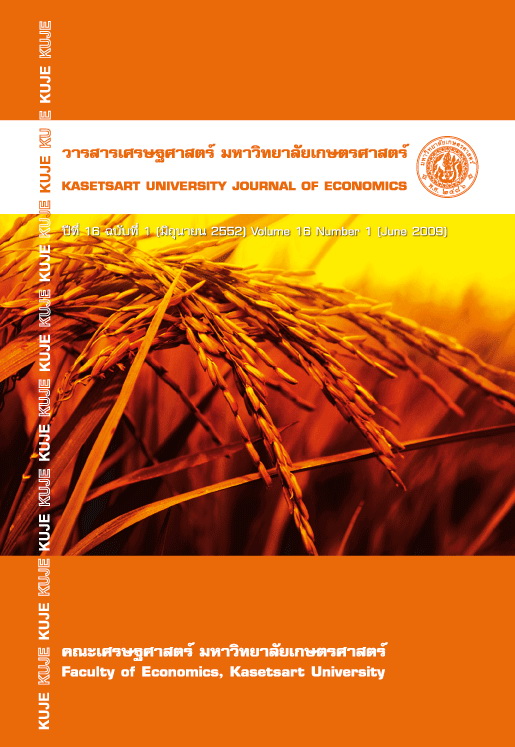ความเอนเอืยงของวิธืดือืเอแบบสองขั้นตอน
Main Article Content
Abstract
บทคัดย่อ
บทความนี้ศึกษาถึงความเอนเอียงของการใช้วิธีดีอีเอแบบสองขั้นตอน โดยขั้นตอนแรกใช้วิธี ดีอีเอประเมินค่าประสิทธิภาพในการจัดการ และขั้นตอนที่สองใช้แบบจำลองโทบิตศึกษาอิทธิพลของตัวแปร ภายนอกที่มีต่อค่าประสิทธิภาพในการจัดการ ข้อมูลที่ใช้ในการวิเคราะห์สร้างขึ้นจากวิธี Monte Carlo โดยกำหนดให้ปัจจัยนำเข้าและตัวแปรภายนอกมีความแปรปรวนและสหสัมพันธ์ ณ ระดับที่แตกต่างกัน ผลการศึกษาพบว่า ความแปรปรวนและขนาดของสหสัมพันธ์ระหว่างปัจจัยนำเข้าและตัวแปรภายนอกมีผลทำให้ค่าประสิทธิภาพในการจัดการที่คำนวณได้มีค่าสูงหรือต่ำกว่าค่าที่ควรจะเป็น ทั้งยังทำให้อิทธิพลของตัวแปร ภายนอกที่มีผลต่อค่าประสิทธิภาพในการจัดการเกิดความเอนเอียงและขาดความเที่ยงตรง ผู้ศึกษาที่จะใช้วิธีดีอีเอแบบสองขั้นตอน จึงควรตรวจสอบความแปรปรวนและขนาดของสหสัมพันธ์ระหว่างปัจจัยนำเข้าและตัวแปรภายนอกเสียก่อน หากพบปัญหาดังกล่าวผู้ศึกษาสามารถแก้ไขได้โดยใช้ตัวแปรผลผลิตขจัดอิทธิพลของตัวแปรภายนอก หรือลดความแปรปรวนของข้อมูลโดยใช้ natural logarithm วิธีการเหล่านี้จะช่วยให้ ค่าประสิทธิภาพในการจัดการที่คำนวณได้มีความถูกต้องและเที่ยงตรงมากขึ้น
คำสำคัญ: วิธีดีอีเอแบบสองขั้นตอน ความเอนเอียง ประสิทธิภาพในการจัดการ
Abstract
This paper studies the bias of using DEA two-stage method for measuring managerial efficiency. In using the method, first, the managerial efficiency is measured by a DEA method. Then, a tobit model is employed to examine the influence of an exogenous variable. Data used in this study were obtained with a Monte Carlo technique. The analysis determines the variance and the correlation of inputs and exogenous variable at different levels. The results show that the variance and the degree of correlation between inputs and exogenous variable significantly influenced the managerial efficiency score. This caused the efficiency score to be either too high or too low compared to the actual value. This also distorted the influence of exogenous variable, which thus caused a bias and gave an imprecise managerial efficiency score. The analyst thus should test the variance and correlation between inputs and exogenous variable before applying the DEA two-stage method. If problems are detected, this can be corrected by ridding the influence of exogenous variable from the output or reducing the variance of the data by using natural logarithm. These techniques would improve the precision of estimating managerial efficiency score.
Keywords: DEA two-stage method, bias evaluation, managerial efficiency
Article Details
The paper is published under CC BY-NC-ND, in which the article is freely downloaded and shared in its original form non-commercially and its citation details are identified.


